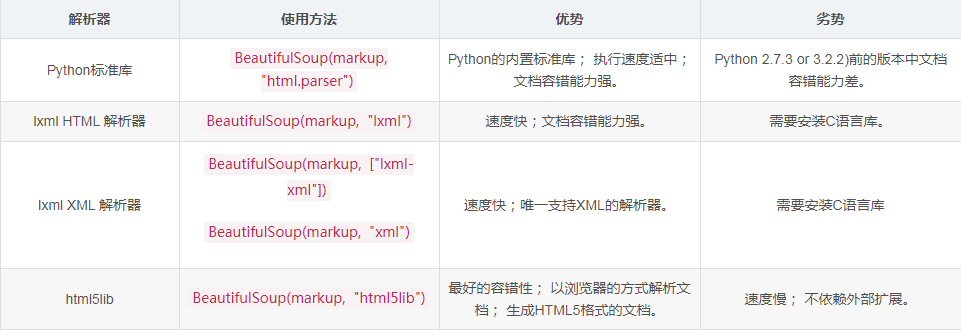您好,登錄后才能下訂單哦!
您好,登錄后才能下訂單哦!
這期內容當中小編將會給大家帶來有關Python爬蟲中BeautifulSoup庫剖析,文章內容豐富且以專業的角度為大家分析和敘述,閱讀完這篇文章希望大家可以有所收獲。
BeautifulSoup 是一個可以從 HTML 或 XML 文件中提取數據的 Python 庫,它能夠將 HTML 或 XML 轉化為可定位的樹形結構,并提供了導航、查找、修改功能,它會自動將輸入文檔轉換為 Unicode 編碼,輸出文檔轉換為 UTF-8 編碼。
BeautifulSoup 支持 Python 標準庫中的 HTML 解析器和一些第三方的解析器,默認使用 Python 標準庫中的 HTML 解析器,默認解析器效率相對比較低,如果需要解析的數據量比較大或比較頻繁,推薦使用更強、更快的 lxml 解析器。
1 安裝
(1)BeautifulSoup 安裝
如果使用 Debain 或 ubuntu 系統,可以通過系統的軟件包管理來安裝:apt-get install Python-bs4,如果無法使用系統包管理安裝,可以使用 pip install beautifulsoup4 來安裝。
(2)第三方解析器安裝
如果需要使用第三方解釋器 lxml 或 html5lib,可是使用如下命令進行安裝:apt-get install Python-lxml(html5lib) 和 pip install lxml(html5lib)。
看一下主要解析器和它們的優缺點:

2 快速上手
將一段文檔傳入 BeautifulSoup 的構造方法,就能得到一個文檔的對象,可以傳入一段字符串或一個文件句柄,示例如下:
(1)使用字符串
我們以如下一段 HTML 字符串為例:
html = ''' <!DOCTYPE html> <html> <head> <meta charset="UTF-8"> <title>BeautifulSoup學習</title> </head> <body> Hello BeautifulSoup </body> </html> '''
使用示例如下:
from bs4 import BeautifulSoup #使用默認解析器 soup = BeautifulSoup(html,'html.parser') #使用 lxml 解析器 soup = BeautifulSoup(html,'lxml')
(2)本地文件
還以上面那段 HTML 為例,將上面 HTML 字符串放在 index.html 文件中,使用示例如下:
#使用默認解析器
soup = BeautifulSoup(open('index.html'),'html.parser')
#使用 lxml 解析器
soup = BeautifulSoup(open('index.html'),'lxml')2.1 對象的種類
BeautifulSoup 將 HTML 文檔轉換成一個樹形結構,每個節點都是 Python 對象,所有對象可以歸納為4種:Tag,NavigableString,BeautifulSoup,Comment。
(1)Tag 對象
Tag 對象與 HTML 或 XML 原生文檔中的 tag 相同,示例如下:
soup = BeautifulSoup('<title>BeautifulSoup學習</title>','lxml')
tag = soup.title
tp =type(tag)
print(tag)
print(tp)
#輸出結果
'''
<title>BeautifulSoup學習</title>
<class 'bs4.element.Tag'>
'''Tag 有很多方法和屬性,這里先看一下它的的兩種常用屬性:name 和 attributes。
我們可以通過 .name 來獲取 tag 的名字,示例如下:
soup = BeautifulSoup('<title>BeautifulSoup學習</title>','lxml')
tag = soup.title
print(tag.name)
#輸出結果
#title我們還可以修改 tag 的 name,示例如下:
tag.name = 'title1' print(tag) #輸出結果 #<title1>BeautifulSoup學習</title1>
一個 tag 可能有很多個屬性,先看一它的 class 屬性,其屬性的操作方法與字典相同,示例如下:
soup = BeautifulSoup('<title>BeautifulSoup學習</title>','lxml')
tag = soup.title
cls = tag['class']
print(cls)
#輸出結果
#['tl']我們還可以使用 .attrs 來獲取,示例如下:
ats = tag.attrs
print(ats)
#輸出結果
#{'class': ['tl']}tag 的屬性可以被添加、修改和刪除,示例如下:
#添加 id 屬性 tag['id'] = 1 #修改 class 屬性 tag['class'] = 'tl1' #刪除 class 屬性 del tag['class']
(2)NavigableString 對象
NavigableString 類是用來包裝 tag 中的字符串內容的,使用 .string 來獲取字符串內容,示例如下:
str = tag.string
可以使用 replace_with() 方法將原有字符串內容替換成其它內容 ,示例如下:
tag.string.replace_with('BeautifulSoup')(3)BeautifulSoup 對象
BeautifulSoup 對象表示的是一個文檔的全部內容,它并不是真正的 HTML 或 XML 的 tag,因此它沒有 name 和 attribute 屬性,為方便查看它的 name 屬性,BeautifulSoup 對象包含了一個值為 [document] 的特殊屬性 .name,示例如下:
soup = BeautifulSoup('<title>BeautifulSoup學習</title>','lxml')
print(soup.name)
#輸出結果
#[document](4)Comment 對象
Comment 對象是一個特殊類型的 NavigableString 對象,它會使用特殊的格式輸出,看一下例子:
soup = BeautifulSoup('<title>Hello BeautifulSoup</title>','html.parser')
comment = soup.title.prettify()
print(comment)
#輸出結果
'''
<title>
Hello BeautifulSoup
</title>
'''我們前面看的例子中 tag 中的字符串內容都不是注釋內容,現在將字符串內容換成注釋內容,我們來看一下效果:
soup = BeautifulSoup('<title><!--Hello BeautifulSoup--></title>','html.parser')
str = soup.title.string
print(str)
#輸出結果
#Hello BeautifulSoup通過結果我們發現注釋符號 <!----> 被自動去除了,這一點我們要注意一下。
2.2 搜索文檔樹
BeautifulSoup 定義了很多搜索方法,我們來具體看一下。
(1)find_all()
find_all() 方法搜索當前 tag 的所有 tag 子節點,方法詳細如下:find_all(name=None, attrs={}, recursive=True, text=None,limit=None, **kwargs),來具體看一下各個參數。
name 參數可以查找所有名字為 name 的 tag,字符串對象會被自動忽略掉,示例如下:
soup = BeautifulSoup('<title>Hello BeautifulSoup</title>','html.parser')
print(soup.find_all('title'))
#輸出結果
#[<title>Hello BeautifulSoup</title>]attrs 參數定義一個字典參數來搜索包含特殊屬性的 tag,示例如下:
soup = BeautifulSoup('<title>Hello BeautifulSoup</title>','html.parser')
soup.find_all(attrs={"class": "tl"})調用 find_all() 方法時,默認會檢索當前 tag 的所有子孫節點,通過設置參數 recursive=False,可以只搜索 tag 的直接子節點,示例如下:
soup = BeautifulSoup('<html><head><title>Hello BeautifulSoup</title></head></html>','html.parser')
print(soup.find_all('title',recursive=False))
#輸出結果
#[]通過 text 參數可以搜搜文檔中的字符串內容,它接受字符串、正則表達式、列表、True,示例如下:
from bs4 import BeautifulSoup
import re
soup = BeautifulSoup('<head>myHead</head><title>BeautifulSoup</title>','html.parser')
#字符串
soup.find_all(text='BeautifulSoup')
#正則表達式
soup.find_all(soup.find_all(text=re.compile('title')))
#列表
soup.find_all(soup.find_all(text=['head','title']))
#True
soup.find_all(text=True)limit 參數與 SQL 中的 limit 關鍵字類似,用來限制搜索的數據,示例如下:
soup = BeautifulSoup('<a id="link1" href="http://example.com/elsie">Elsie</a><a id="link2" href="http://example
.com/elsie">Elsie</a>','html.parser')
soup.find_all('a', limit=1)我們經常見到 Python 中 *arg 和 **kwargs 這兩種可變參數,*arg 表示非鍵值對的可變數量的參數,將參數打包為 tuple 傳遞給函數; **kwargs 表示關鍵字參數,參數是鍵值對形式的,將參數打包為 dict 傳遞給函數。
使用多個指定名字的參數可以同時過濾 tag 的多個屬性,如:
soup = BeautifulSoup('<a id="link1" href="http://example.com/elsie">Elsie</a><a id="link2" href="http://example
.com/elsie">Elsie</a>','html.parser')
soup.find_all(href=re.compile("elsie"),id='link1')有些 tag 屬性在搜索不能使用,如 HTML5 中的 data-* 屬性,示例如下:
soup = BeautifulSoup('<div data-foo="value">foo!</div>')
soup.find_all(data-foo='value')首先當我在 Pycharm 中輸入 data-foo='value' 便提示語法錯誤了,然后我不管提示直接執行提示 SyntaxError: keyword can't be an expression 這個結果也驗證了 data-* 屬性在搜索中不能使用。我們可以通過 find_all() 方法的 attrs 參數定義一個字典參數來搜索包含特殊屬性的 tag,示例如下:
print(soup.find_all(attrs={'data-foo': 'value'}))(2)find()
方法詳細如下:find(name=None, attrs={}, recursive=True, text=None,**kwargs),我們可以看出除了少了 limit 參數,其它參數與方法 find_all 一樣,不同之處在于:find_all() 方法的返回結果是一個列表,find() 方法返回的是第一個節點,find_all() 方法沒有找到目標是返回空列表,find() 方法找不到目標時,返回 None。來看個例子:
soup = BeautifulSoup('<a id="link1" href="http://example.com/elsie">Elsie</a><a id="link2" href="http://example
.com/elsie">Elsie</a>','html.parser')
print(soup.find_all('a', limit=1))
print(soup.find('a'))
#輸出結果
'''
[<a href="http://example.com/elsie" id="link1">Elsie</a>]
<a href="http://example.com/elsie" id="link1">Elsie</a>
'''從示例中我們也可以看出,find() 方法返回的是找到的第一個節點。
(3)find_parents() 和 find_parent()
find_all() 和 find() 用來搜索當前節點的所有子節點,find_parents() 和 find_parent() 則用來搜索當前節點的父輩節點。
(4)find_next_siblings() 和 find_next_sibling()
這兩個方法通過 .next_siblings 屬性對當前 tag 所有后面解析的兄弟 tag 節點進行迭代,find_next_siblings() 方法返回所有符合條件的后面的兄弟節點,find_next_sibling() 只返回符合條件的后面的第一個tag節點。
(5)find_previous_siblings() 和 find_previous_sibling()
這兩個方法通過 .previous_siblings 屬性對當前 tag 前面解析的兄弟 tag 節點進行迭代,find_previous_siblings() 方法返回所有符合條件的前面的兄弟節點,find_previous_sibling() 方法返回第一個符合條件的前面的兄弟節點。
(6)find_all_next() 和 find_next()
這兩個方法通過 .next_elements 屬性對當前 tag 之后的 tag 和字符串進行迭代,find_all_next() 方法返回所有符合條件的節點,find_next() 方法返回第一個符合條件的節點。
(7)find_all_previous() 和 find_previous()
這兩個方法通過 .previous_elements 屬性對當前節點前面的 tag 和字符串進行迭代,find_all_previous() 方法返回所有符合條件的節點,find_previous() 方法返回第一個符合條件的節點。
2.3 CSS選擇器
BeautifulSoup 支持大部分的 CSS 選擇器,在 Tag 或 BeautifulSoup 對象的 .select() 方法中傳入字符串參數,即可使用 CSS 選擇器的語法找到 tag,返回類型為列表。示例如下:
soup = BeautifulSoup('<body><a id="link1">Elsie</a><a id="link2">Elsie</a></body>','html.parser')
print(soup.select('a'))
#輸出結果
#[<a clss="elsie" id="link1">Elsie</a>, <a clss="elsie" id="link2">Elsie</a>]通過標簽逐層查找
soup.select('body a')找到某個 tag 標簽下的直接子標簽
soup.select('body > a')通過類名查找
soup.select('.elsie')
soup.select('[class~=elsie]')通過 id 查找
soup.select('#link1')使用多個選擇器
soup.select('#link1,#link2')通過屬性查找
soup.select('a[class]')通過屬性的值來查找
soup.select('a[class="elsie"]')查找元素的第一個
soup.select_one('.elsie')查找兄弟節點標簽
#查找所有
soup.select('#link1 ~ .elsie')
#查找第一個
soup.select('#link1 + .elsie')上述就是小編為大家分享的Python爬蟲中BeautifulSoup庫剖析了,如果剛好有類似的疑惑,不妨參照上述分析進行理解。如果想知道更多相關知識,歡迎關注億速云行業資訊頻道。
免責聲明:本站發布的內容(圖片、視頻和文字)以原創、轉載和分享為主,文章觀點不代表本網站立場,如果涉及侵權請聯系站長郵箱:is@yisu.com進行舉報,并提供相關證據,一經查實,將立刻刪除涉嫌侵權內容。